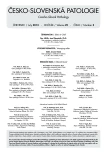-
Medical journals
- Career
Polymerase chain reaction: basic principles and applications in molecular pathology
Authors: Libor Staněk
Authors‘ workplace: Ústav patologie 1. LF UK a VFN, Praha
Published in: Čes.-slov. Patol., 49, 2013, No. 3, p. 119-121
Category: Reviews Article
Overview
Polymerase chain reaction (PCR) is a technology used for quick and easy amplifying DNA sequences, which is based on the principle of enzymatic replication of the nucleic acids. This method has in the field of molecular biology an irreplaceable role and constitutes one of the basic methods for DNA analysis. In the following article we describe the basic principles of PCR, and its importance especially in the field of pathology.
Keywords:
polymerase chain reaction – nucleic acid amplification – primers – detection of amplicons – reverse transcription
Sources
1. Coleman WB, Tsongalis GJ. Molecular Patology. Elsevier: USA; 2009 : 197–207.
2. Kolář Z, Bouchal J, Knillová J. Molekulární patologie nádorů. Epava: Olomouc; 2003 : 113–142.
3. Powledge TM. The polymerase chain reaction. Advances in Physiology Education 2004; 28 : 44–50.
4. Rosypal S. Úvod do molekulární biologie, díl třetí. Grafex: Brno; 1999 : 743.
5. Šmarda J, Doškář J, Pantíček R, Růžičková V, Kostíková J. Metody molekulární biologie. Masarykova univerzita v Brně: Brno; 2008 : 13–16; 73–104.
6. Konrad M. A (short) history of PCR. http://www.scienceisart.com/A_PCR/PCR history_2. html.
7. Brown TA. Klonování genů a analýza DNA. Univerzita Palackého v Olomouci:
Olomouc; 2007 : 3–12; 184–189.
Labels
Anatomical pathology Forensic medical examiner Toxicology
Article was published inCzecho-Slovak Pathology

2013 Issue 3-
All articles in this issue
- Polymerase chain reaction: basic principles and applications in molecular pathology
- Sequencing – classical method
- Next-generation sequencing
- False aneurysm of the wall of a venous graft in a patient with an implanted MGuard type of coronary stent: case report and description of the microscopic changes
- Giant cell interstitial pneumonia without exposure to hard metals
- Endometriosis in a mesothelial cyst of tunica vaginalis of the testis. Report of a case
- Czecho-Slovak Pathology
- Journal archive
- Current issue
- Online only
- About the journal
Most read in this issue- Polymerase chain reaction: basic principles and applications in molecular pathology
- Sequencing – classical method
- Next-generation sequencing
- Endometriosis in a mesothelial cyst of tunica vaginalis of the testis. Report of a case
Login#ADS_BOTTOM_SCRIPTS#Forgotten passwordEnter the email address that you registered with. We will send you instructions on how to set a new password.
- Career

